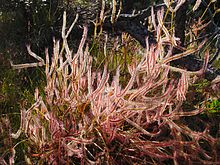Drosera binata
| Drosera binata | |
|---|---|

| |

| |
| Scientific classification | |
| Kingdom: | Plantae |
| Clade: | Tracheophytes |
| Clade: | Angiosperms |
| Clade: | Eudicots |
| Order: | Caryophyllales |
| Family: | Droseraceae |
| Genus: | Drosera |
| Subgenus: | Drosera subg. Phycopsis ( Planch.) Schlauer
|
| Species: | D. binata
|
| Binomial name | |
| Drosera binata | |

| |
| Occurrence data from AVH | |
| Synonyms | |
Drosera binata, commonly known as the forked sundew or fork-leaved sundew. It is a large,
Like all sundews, it is a carnivorous plant. It is unique among sundews in having narrow, branching leaves. It is the only species in the Drosera subgenus Phycopsis.
D. binata occurs naturally in Australia, primarily in coastal areas from
Some populations go dormant in the winter, while others are truly tropical.Taxonomy and botanical history
Plants similar to the
The second observed form, commonly referred to as
A third described form, often called D. binata f. multifida, has even more leaf divisions, bifurcating several times to produce anywhere from eight to 16 or even 30 terminal leaf points.[4][5] This, too, was published by J. A. Mazrimas in the same 1976 volume of the Carnivorous Plant Newsletter as var. multifida, referring to the description of a 27-point D. binata found by George Ashley and published in a 1975 volume of the Carnivorous Plant Newsletter.[8][10] Neither of these names were validly published, but again they remain in use among carnivorous plant growers. A final form, known for producing up to 40 terminal leaf points, is frequently titled f. extrema, another name that has never been validly published but remains in use.[4]
Two cultivars of D. binata have been named. Drosera 'Giant' is a particularly large form of the "var. dichotoma" type and was published by Peter D'Amato in 1998 and registered in 1999. The other, Drosera 'Marston Dragon', was published by Adrian Slack in 1986 and registered in 2001.[6]
See also
References
- ^ "Drosera binata". Australian Plant Name Index, IBIS database. Centre for Plant Biodiversity Research, Australian Government.
- ^ Labillardiere, J.J.H. de (1805) Novae Hollandiae Plantarum Specimen 1(9-10): 78, t. 105
- ^ a b Salmon, B. 2001. Carnivorous Plants of New Zealand. Ecosphere Publications.
- ^ a b c d e f Gilbert, I. 1984. Drosera binata. Carnivorous Plant Newsletter, 13(3): 74-76.
- ^ a b c Rice, B. 2010. Any other Drosera species. The Carnivorous Plant FAQ v. 11.5. Retrieved 25 January 2010.
- ^ a b c Schlauer, J. 2010. World Carnivorous Plant List - Nomenclatural Synopsis of Carnivorous Phanerogamous Plants Archived 2016-09-18 at the Wayback Machine. Retrieved 25 January 2010.
- ^ "Drosera binata". International Plant Names Index (IPNI). Royal Botanic Gardens, Kew; Harvard University Herbaria & Libraries; Australian National Botanic Gardens. Retrieved 25 January 2010.
- ^ a b Mazrimas, J. A. 1976. The Drosera binata complex. Carnivorous Plant Newsletter, 5(1): 15.
- ^ Darwin, C. 1875. Insectivorous Plants. London: John Murray. pp. 281-282.
- ^ Ashley, G. 1975. The search for the 27 point Drosera binata. Carnivorous Plant Newsletter, 4(3): 48.
